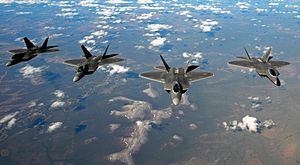Last week, the U.S. House of Representatives commissioned a study on resuming production of the Lockheed Martin F-22 Raptor. The F-22 completed its production run in 2011, after a controversial decision by Secretary of Defense Robert Gates to curtail the fighter in favor of simpler, less expensive projects.
As numerous analysts have pointed out, the costs of resuming the F-22 production line would be staggering. Although Lockheed Martin tried to retain all of the tooling and equipment necessary to restart the line, much of the human capital associated with assembly has been lost. Moreover, engineers have struggled to find the appropriate equipment in storage, even for the repair and maintenance of the existing fleet.
There are other objections, beyond cost. Its outstanding quality notwithstanding, the F-22 is an old airframe, and a redesigned “F-22B” capable of integrating the latest in electronics and avionics would incur a substantial up-front cost. While focusing on the F-22 at the expense of the F-35 sounds appealing, restarting the line would draw resources away from other Air Force priorities and would do nothing whatsoever to solve the fighter problems faced by the Navy or the Marine Corps.
Nevertheless, the F-22 remains superior to any competitor either in the air or in the pre-production phase. This almost certainly includes the Russian PAK FA as well as the Chinese J-20 and J-31. Given the continuing struggles faced by the F-35, at the very least restarting the F-22 could ensure that the United States flies adequate numbers of the world’s best fighter for the next decade or so.
But what about U.S. allies? Gates decided to kill the F-22, at least in part, because of the export prospects (and multilateral commitments) of the F-35 program. The F-22 suffered because of Congress’ decision to ban export of the aircraft, a decision that made some sense at the time but has increasingly looked like a particularly egregious error. Export remains the holy grail for the F-22. If the United States could generate an export market for the F-22, it could significantly reduce the costs of restarting the line.
Logically, the key reasons for resisting export of the F-22 have disappeared. Although the fighter remains state of the art, the cat is largely out of the bag with respect to stealth technology. The most likely customers (Japan, South Korea, and Israel) will also purchase the F-35, and, in the former two cases, will continue to develop their own stealth aircraft. And the fighter would surely find other buyers as well.
Still, restarting the F-22 remains a long-shot. The industry lacks a really good reason for a restart, and uncertainty about the fighter’s export future will probably preclude the development of an international coalition to build the plane. The F-22 will likely remain a (highly effective) boutique aircraft.
































